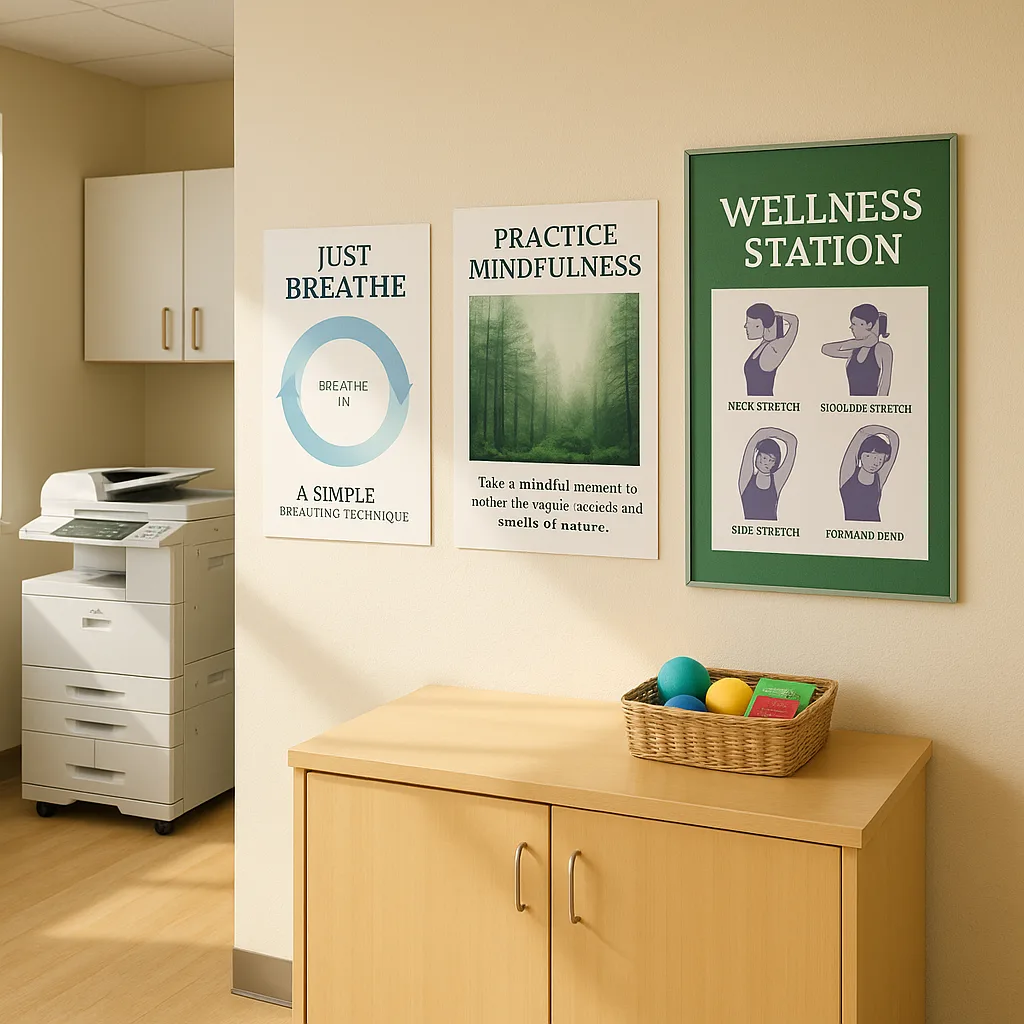Poster Making Machine Wellness Stations | Teacher Self-Care
The Teacher Wellness Corner
Designing Self-Care Reminder Stations That Actually Get Used

Strategic Placement: Where Poster Making Machine Wellness Stations Actually Work
Location isn’t just important—it’s everything. Through my work with over 200 schools, I’ve identified the most effective placement zones for wellness stations. These aren’t random choices; they’re based on traffic patterns, stress points, and natural pause moments in a teacher’s day.
Copy Room Corner
Why It Works
Teachers spend 3-5 minutes here daily, creating a natural pause for mindfulnessStaff Bathroom Mirrors
The Science
Mirror neurons activate self-reflection, making affirmations 40% more effective hereRotating Content Strategies: Keeping Wellness Fresh with Your Poster Making Machine
Static wellness boards become wallpaper within weeks. The solution? A strategic rotation system powered by your school’s poster making capabilities. Here’s my research-backed rotation schedule that maintains engagement throughout the school year:
Overcoming Common Wellness Station Challenges
Let me address the elephant in the staff room: wellness initiatives can feel performative or patronizing. Through my consulting work, I’ve learned that teachers resist wellness stations when they feel:
1. Generic or disconnected from their reality – Solution: Use your poster making machine to create school-specific content addressing your unique challenges
2. Preachy or guilt-inducing – Solution: Frame messages as invitations, not imperatives (“You might enjoy…” vs. “You should…”)
3. Time-intensive or complicated – Solution: Focus on 30-second techniques that can be done between classes
4. Imposed from administration – Solution: Involve teacher wellness committees in content creation
Measuring Success: Beyond Feel-Good Metrics
How do you know if your poster making machine wellness stations are actually working? Traditional metrics like “number of posters displayed” miss the point. Instead, I recommend tracking:
Behavioral Indicators:
• Increased use of designated calm-down spaces
• More teachers taking full lunch breaks
• Decreased sick days during high-stress periods
Engagement Markers:
• Teachers photographing and sharing wellness content
• Requests for specific topics or techniques
• Voluntary contributions to rotation content
Cultural Shifts:
• Normalized conversations about stress and self-care
• Peer-to-peer wellness support increasing
• Integration of wellness language in team meetings
Your Wellness Station Action Plan
Creating effective wellness stations doesn’t require perfection—it requires intention. Start small with these evidence-based steps:
1. This Week: Walk your building and identify three high-traffic pause points for wellness stations
2. Next Week: Survey staff about their top three stress points and preferred self-care activities
3. Within a Month: Design and print your first set of wellness posters using calming colors and simple messages
4. Ongoing: Establish a monthly rotation schedule with seasonal themes
Remember, the goal isn’t to eliminate teacher stress—that’s unrealistic. The goal is to create visual touchpoints that remind educators they’re worth caring for, even on the hardest days. Your poster making machine wellness stations can become anchors of calm in the beautiful chaos of school life.
As I often share in my workshops, sometimes the most powerful intervention is simply a well-placed reminder to breathe. When we support teacher wellness visually and consistently, we’re not just decorating walls—we’re building a culture where self-care becomes as natural as lesson planning.
What wellness message would resonate most with your staff right now? I’d love to hear your ideas in the comments below. Together, we can transform school wellness from an afterthought to an integral part of educational excellence.

